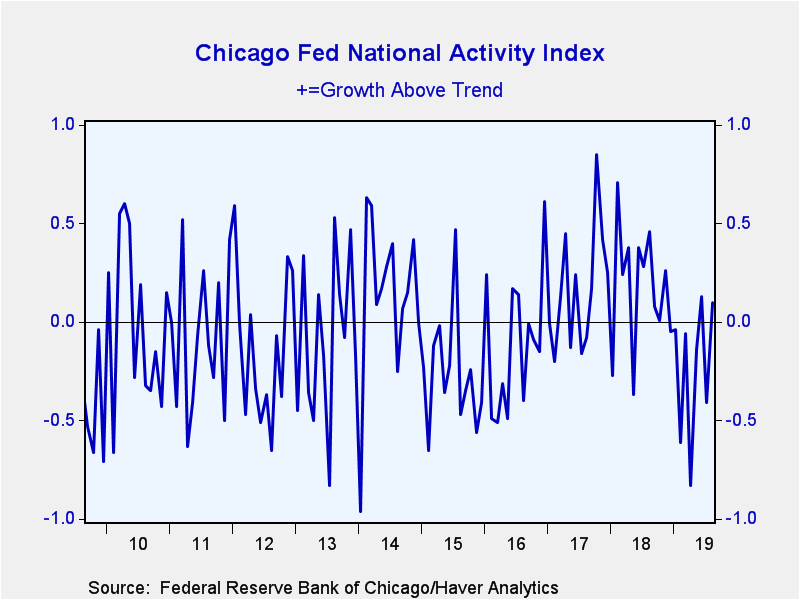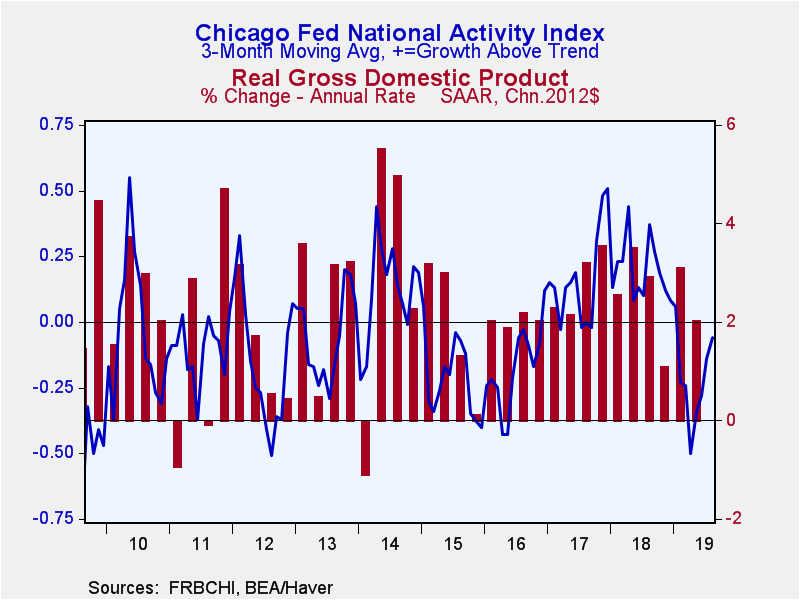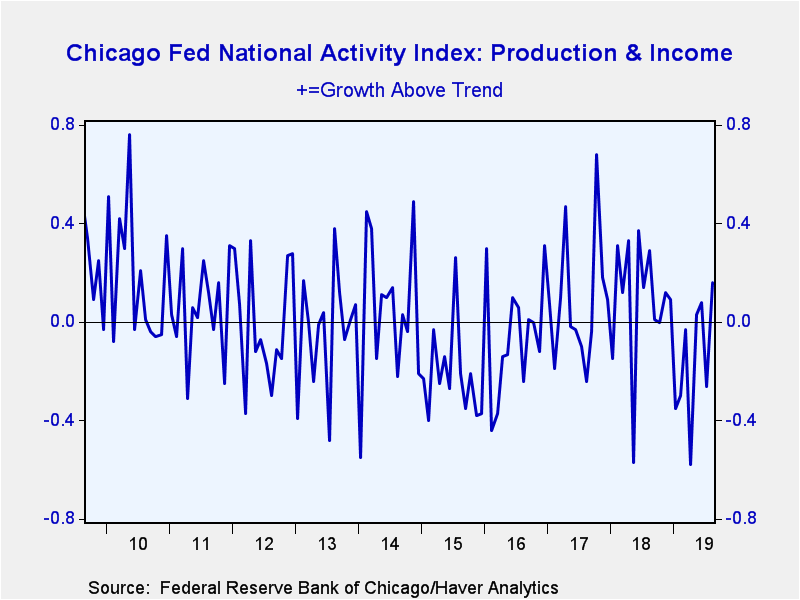 Global| Sep 23 2019
Global| Sep 23 2019Chicago Fed National Activity Index Improves
by:Tom Moeller
|in:Economy in Brief
Summary
The Federal Reserve Bank of Chicago reported that its National Activity Index rose to 0.10 during August from -0.41 in July. The three-month moving average, which irons out volatility in the monthly figures, rose to -0.06 last month [...]
The Federal Reserve Bank of Chicago reported that its National Activity Index rose to 0.10 during August from -0.41 in July. The three-month moving average, which irons out volatility in the monthly figures, rose to -0.06 last month versus July's reading of -0.14. It was the highest level since January and sharply above the April low. During the last twenty years, there has been a 70% correlation between the Chicago Fed Index and the q/q change in real GDP.
The National Activity Diffusion Index, which measures the breadth of movement in the monthly series, also improved to -0.12 from -0.20. That remained below the peak of 0.41 in December 2017.
Improvement in the August index reflected increases in each of the component series. The Production & Income series led the gains with improvement to 0.16, its highest level in 12 months. The Sales, Orders & Inventories sub-group rose to -0.02 from -0.07, but remained well below its earlier highs. The Employment, Unemployment & Hours series recaptured its July decline and rose to -0.02 from -0.05. It has been moving sideways for six months. The Personal Consumption & Housing reading edged higher to -0.02 from -0.03, yet remained above February's low of -0.11.
The CFNAI is a weighted average of 85 indicators of national economic activity. It is constructed to have an average value of zero and a standard deviation of one. Since economic activity tends toward trend growth rate over time, a positive index reading corresponds to growth above trend and a negative index reading corresponds to growth below trend.
The Chicago Federal Reserve figures are available in Haver's SURVEYS database.
| Chicago Federal Reserve Bank | Aug | Jul | Jun | Aug '18 | 2018 | 2017 | 2016 |
|---|---|---|---|---|---|---|---|
| National Activity Index (percent) | 0.10 | -0.41 | 0.13 | 0.46 | 0.18 | 0.16 | -0.11 |
| 3-Month Moving Average | -0.06 | -0.14 | -0.28 | 0.37 | -- | -- | -- |
| Diffusion Index | -0.12 | -0.20 | -0.11 | 0.27 | 0.17 | 0.09 | -0.19 |
| Production & Income | 0.16 | -0.26 | 0.08 | 0.29 | 0.09 | 0.08 | -0.06 |
| Employment, Unemployment & Hours | -0.02 | -0.05 | -0.02 | 0.06 | 0.12 | 0.08 | 0.02 |
| Personal Consumption & Housing | -0.02 | -0.03 | -0.05 | -0.04 | -0.06 | -0.05 | -0.07 |
| Sales, Orders & Inventories | -0.02 | -0.07 | 0.12 | 0.16 | 0.02 | 0.05 | -0.01 |
Tom Moeller
AuthorMore in Author Profile »Prior to joining Haver Analytics in 2000, Mr. Moeller worked as the Economist at Chancellor Capital Management from 1985 to 1999. There, he developed comprehensive economic forecasts and interpreted economic data for equity and fixed income portfolio managers. Also at Chancellor, Mr. Moeller worked as an equity analyst and was responsible for researching and rating companies in the economically sensitive automobile and housing industries for investment in Chancellor’s equity portfolio. Prior to joining Chancellor, Mr. Moeller was an Economist at Citibank from 1979 to 1984. He also analyzed pricing behavior in the metals industry for the Council on Wage and Price Stability in Washington, D.C. In 1999, Mr. Moeller received the award for most accurate forecast from the Forecasters' Club of New York. From 1990 to 1992 he was President of the New York Association for Business Economists. Mr. Moeller earned an M.B.A. in Finance from Fordham University, where he graduated in 1987. He holds a Bachelor of Arts in Economics from George Washington University.










